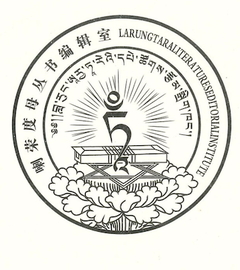Chen Teye
Translator's Introduction
The story of Chen Taye is found in the Ḍākinīs' Great Dharma Treasury (mkha' 'gro'i chos mdzod chen mo) in a section dedicated to stories of Chinese women saints translated to Tibetan by Khenmo Dawa Drolma. The story is about a thirteenth-century Japanese meditation master, and it either echoes or precedes the famous story of Ryōnen Gensō (17th–18th c.).[1]
The Nun Chen Teye: A Master from Japan
from the Ḍākinīs' Great Dharma Treasury
Chen Teye was one of the most beautiful women in the world. On top of that, her family was rich and influential, so many famous and powerful suitors vied to marry her. From the time she was young, however, she had little interest in a life of power and wealth. Instead, she listened to many teachers speak about the Buddhadharma, and a natural sense of renunciation welled up within her. With a fierce desire to take monastic ordination, she approached several teachers. However, because of her beauty, none of them were comfortable accepting her as a disciple. The teachers all reasoned that if such a beautiful woman attempted to guard the strictures of ordination, she would face too many obstacles.
After several rejections, she asked for monastic ordination from Master Taicho,[1] who discouraged her from pursuing the Dharma, saying, “Throughout time, being beautiful has been a hindrance to a young woman’s ordination. I fear that it would be very difficult for you to reach the goal of practice, and this could cast doubt on the Buddha's teachings. You should go.” Thus, he also would not take her as a student.
Her desire for ordination was so strong, however, that she took coals from a fire and burned the entire surface of her face, completely disfiguring herself. She then went back to Master Taicho. He was astonished by what she had done. He accepted her as a student and granted her ordination. After that, she worked for thirty years drawing water, carrying wood, and growing vegetables for the monastic cafeteria.
On a full-moon evening in 1292, while carrying water, she sat to rest for a bit on the trail. She saw the moon’s reflection shimmering in the bucket of water beside her. It made her feel happy, and she remained there, transfixed by it. Suddenly, the strap holding her bucket together snapped, and the bucket fell apart. At that moment, with both the water and the moon’s reflection gone, she directly perceived the nature of reality. She then sang this spontaneous song:
Without water, the moon does not reflect. To protect my pail, I did everything I could to bind it with weak reeds. Though I expected it to last forever, suddenly, the bottom fell out. There is no water, and there is no moon. It is out of my hands.
After this experience, she became one of the most renowned disciples of Master Fo Gang.[2] In her golden years, she dedicated herself to sharing meditation instructions and founded Nu'e Nunnery at the Five Mountains of Chentö, one of the most esteemed nunneries of its time.[3]
This story was translated to Tibetan from Chinese sources by Khenmo Dawa Drolma.
| Translated by Joseph McClellan, 2025.
Bibliography
Tibetan Source
mkhan mo zla ba sgrol ma, trans. 2017. "'jar pan gyi sgom chen ma bstun ma chan ta ye." In mkhaʼ ʼgroʼi chos mdzod chen mo (Par gzhi dang poʼi par thengs dang po, Vol. 8, pp. 297–298). Bod ljongs bod yig dpe rnying dpe skrun khang. BDRC MW3CN2459_CCD881.
Secondary Source
Graham, Patricia J. 2007. Expressions of Faith. In Faith and Power in Japanese Buddhist Art, 1600–2005. Honolulu: University of Hawai’i Press.
Version: 1.0-20250707
-
sgom chen ta co. We render it Taicho, assuming its Japanese origins. ↩
-
h+pho gang sgom chen. ↩
-
This final passage is tentative. It reads: can tos ri lnga'i jo dgon dang po nu e dgon pa gsar bkrun mdzad. It is unclear exactly what can tos ri lnga refers to. Ri lnga, in similar contexts, refers to the holy site of Wutai Shan in China, though the subject here seems to be limited to Japan. Thus, it is unclear what can tos refers to. It is either a transliteration of a Chinese term, or it may be a corrupted agentive case of the subject's name Chen Teye (chan te ye). ↩
